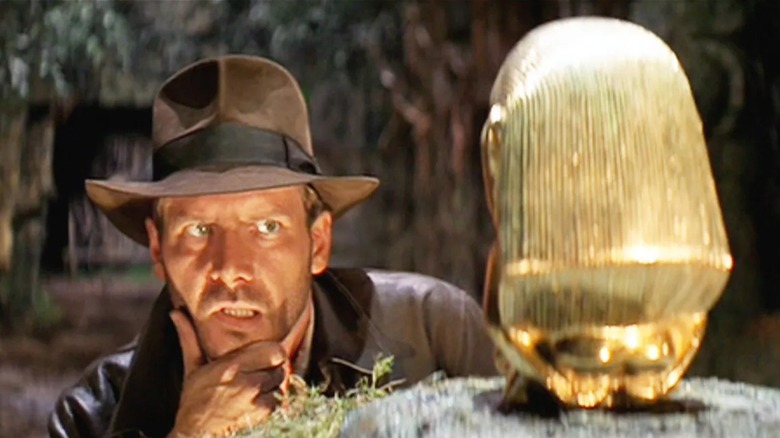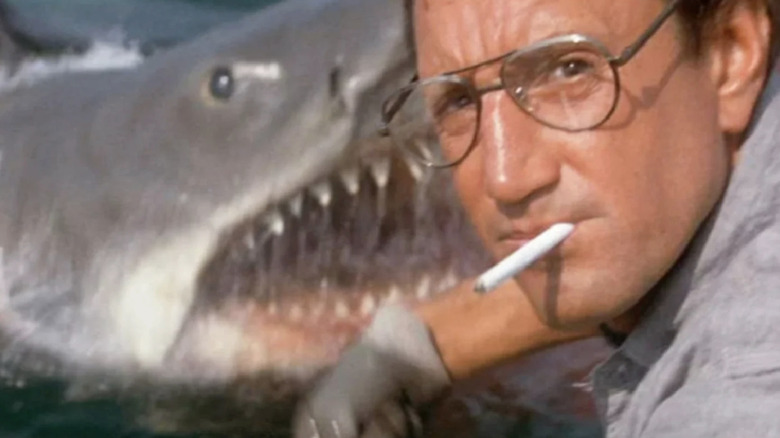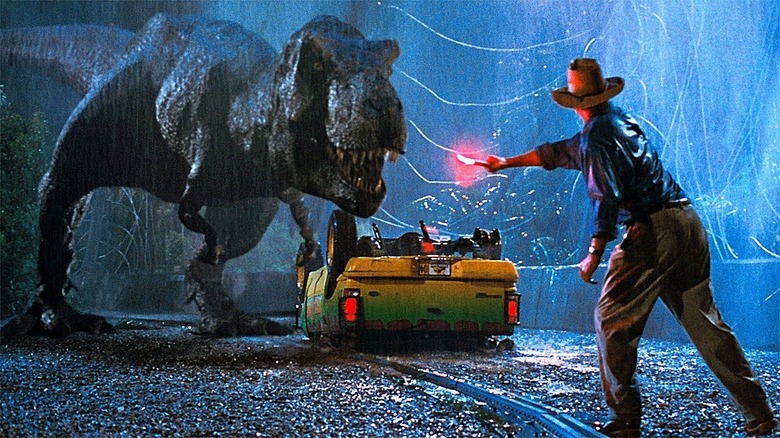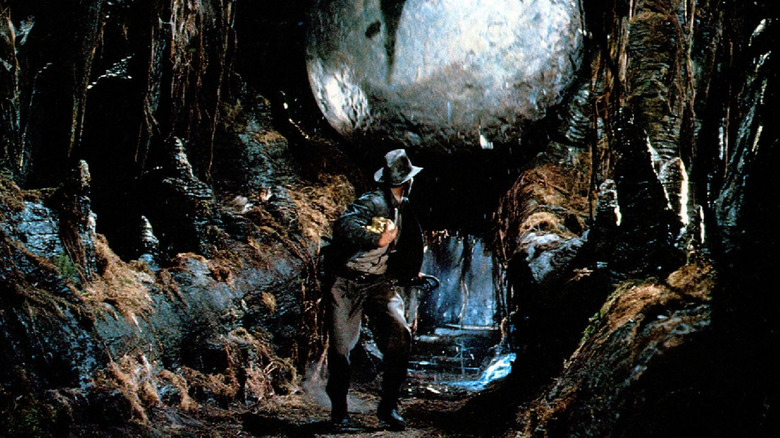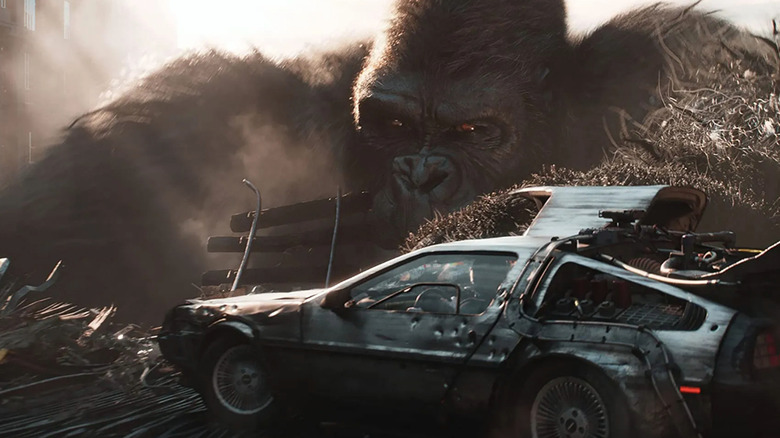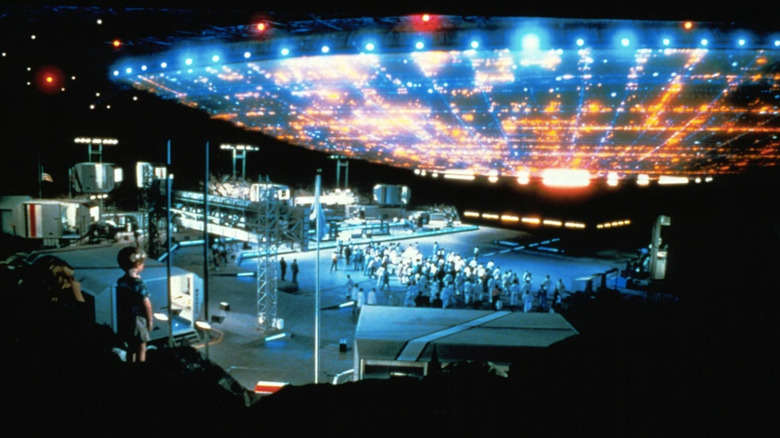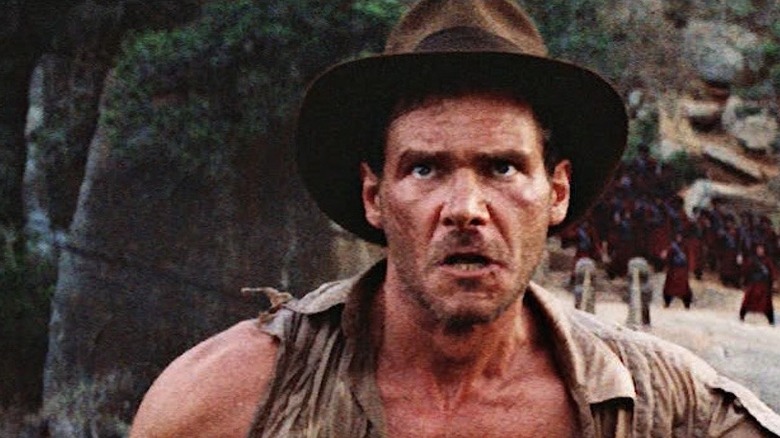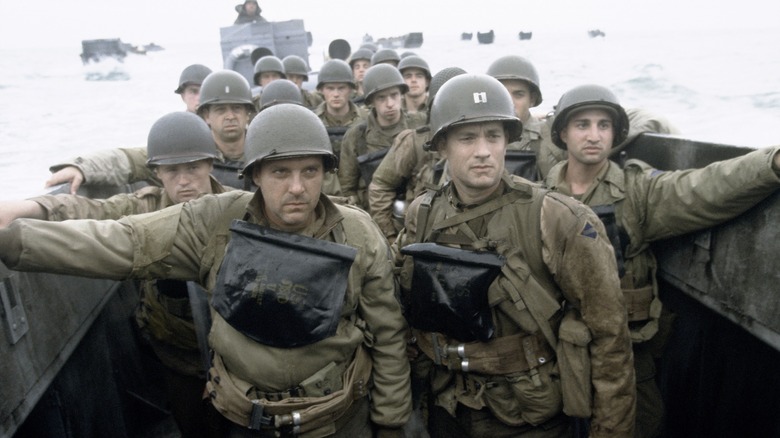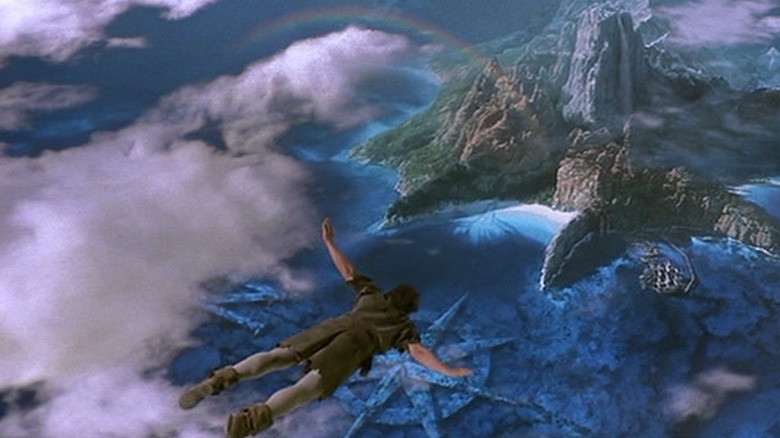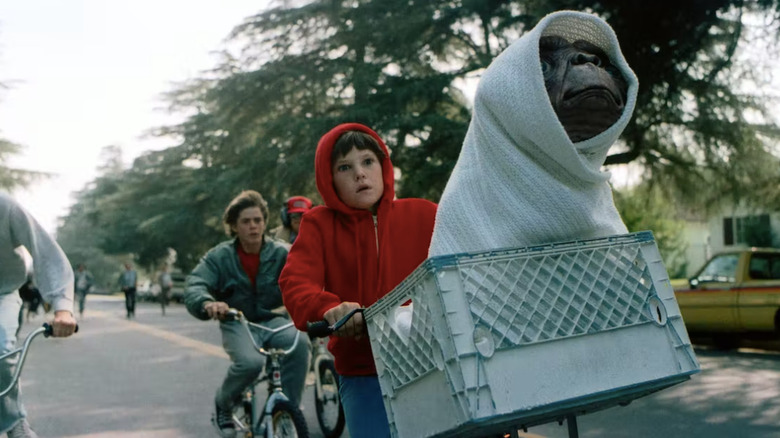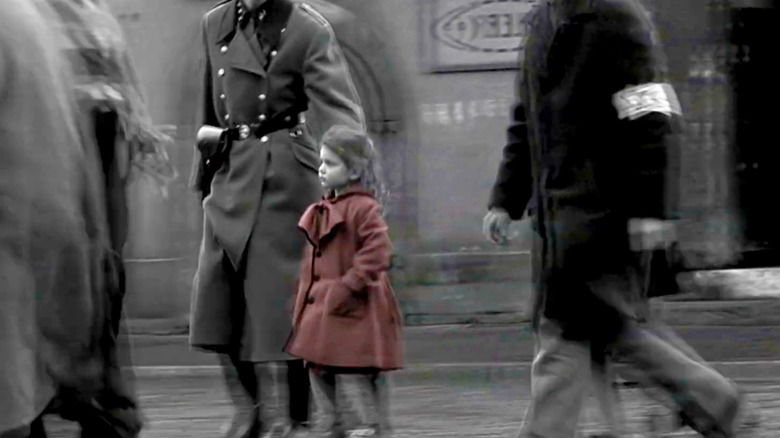10 Moments In Steven Spielberg Movies That Blew Our Minds
When it comes to mainstream American cinema, is there a more prominent or influential name than Steven Spielberg? For over 50 years the filmmaker with the iconic beard has made hits of almost everything he's put his name to. From groundbreaking modern classics like "Raiders of the Lost Ark," "E.T: The Extra-Terrestrial" and "Jurassic Park," to producing nostalgic mega-hits like "Back To The Future," "Gremlins" and "The Goonies," Spielberg could arguably be labeled as one of the chief architects of modern pop-culture as we know it.
Rose-tinted glasses aside, this iconic moviemaker has also helped push the boundaries of what a big-screen adventure can look like and the technical scale at which they are told. Spielberg's extensive body of work has emerged with a baked-in ability to withstand the test of time, all while serving as many a future cinephile's wholesome first steps into the illustrious, varied, and dazzling world of movies at large. As his latest, semi-autobiographical feature "The Fabelmans" sends awards season voices chattering, the 75-year-old director shows no sign of slowing, the creative light that powers his endeavors brighter than ever. With an enviable body of work created over half a century behind the camera, we're showcasing the 10 moments in Steven Spielberg movies that well and truly blew the minds of audiences across the globe.
Jaws (1975) — 'We're Going to need a bigger boat'
When it comes to scenes that caused our eyes to pop and jaws to drop, Steven Spielberg started strong with an iconic sequence in one of his earliest hits. As the film that helped coin the concept of a summer blockbuster, "Jaws" defied its problem-plagued shoot to emerge as the highest-grossing movie of 1975 and the calling card picture for a young filmmaker on the rise. Released when Spielberg was just 27 years old, this nail-biting adaptation of Peter Benchley's eponymous novel about a giant shark terrorizing a seaside town left audiences with a universal fear of the water, while allowing composer John Williams to do wonders with a creeping, minimalistic score.
There are any number of effective shots to gawp at throughout the film's 124-minute runtime. However, perhaps its most memorable (and most frequently quoted) appears about three-quarters of the way through the movie. As police chief Brody (Roy Scheider) and shark expert Hooper (Richard Dreyfuss) join Quint (Robert Shaw) on an open-sea quest to stop the film's toothy terror in its tracks, Brody suddenly comes face to face with the beast itself while shoveling chum into the briny deep. Wide-eyed and visibly terrified at the size of their underwater foe, he utters the classic line "We're going to need a bigger boat..." to Quint, mirroring the shocked terror of the audiences themselves. Rumour has it the line was an in-joke, referring to the troubled nature of Spielberg's shoot.
Jurassic Park (1993) — T-Rex Escape
It could be argued that cinema's major leaps forward can be split into three distinct categories: color, sound, and "Jurassic Park." Steven Spielberg's hugely ambitious adaptation of Michael Crichton's forward-thinking novel quite literally changed the game when it came to the creation and potential of movie-making. The whole off-screen journey is fascinating in and of itself, one that any movie fan will no doubt eat up. If you haven't already, we highly recommend checking out Lawrence Kasdan's brilliant Disney+ docuseries "Light & Magic," which details the inspiration behind — and creation of — Industrial Light and Magic, the visual effects house that forever changed how modern movies are made.
While that series does a better job of detailing the crazy story leading up to "Jurassic Park" than we ever could, all of it is personified in this one masterful sequence. Having teased us early on, it's not until the dino droppings really hit the fan that we get a good look at the primal power of the CGI monsters Spielberg and his effects team have cooked up. With the power in the park cut off, the star of the show is suddenly free to roam, and as we watch the T-rex stomp its way out of its enclosure and into the wider island, it's not just doctors Alan Grant and Ian Malcolm who are left slack-jawed and agog at the wonder unfolding before their eyes.
Raiders Of The Lost Ark (1981) — Boulder Scene
The opening of 1981's "Raiders of the Lost Ark" is not only an iconic entry into Steven Spielberg's already impressive oeuvre but a signature moment from one of the director's most beloved creations. Together with his pal George Lucas, the filmmaker transformed his desire to helm a James Bond mission into something new, enlisting the help of Han Solo himself Harrison Ford to create a love letter to Saturday morning adventure serials of old. The end result was a film that reignited our fascination with old-school action and introduced us to the whip-wielding archaeologist Indiana Jones. To help set the scene for his treasure-hunting world, Spielberg took us deep inside a Peruvian temple where the quest for an ancient golden idol sent the adventurer on a mile-a-minute brush with death as he narrowly avoids walls with sharp spikes and poison darts.
However, the centerpiece of Indy's debut is so big it has forever ingrained itself into cinema history. "The 12-foot rock which chases Harrison Ford in the cave sequence would have killed whoever it ran over," explained Spielberg in a 2017 essay for American Cinematographer, detailing how Ford did his own stunts. "There were five shots of the rock from five different angles — each one done separately, each one done twice — so Harrison had to race the rock ten times. He won ten times — and beat the odds. He was lucky — and I was an idiot for letting him try it."
Ready Player One (2018) — Race Scene
It'd likely take us all day to list all the cool Easter Eggs and movie references scattered throughout Steven Spielberg's adaptation of Ernest Cline's meta-adventure "Ready Player One." The film is a celebration of the very same pop-culture nostalgia that Spielberg himself is largely responsible for giving us in the first place, which is why it was all the more fitting that he decided to bring this ambitious project to the big screen. That said, perhaps he was the only one that could. After all, we haven't seen so many intellectual property crossovers since Robert Zemeckis' 1988 gem "Who Framed Roger Rabbit" which Spielberg executive produced and in turn, helped secure so many famous faces playing in the same sandbox.
Ever aware of what his audience wants, Spielberg serves us up a juicy slice of nostalgia front and center in this key scene that follows our hero Parzival (Tye Sheridan) attempting to win a high-octane race and secure an all-important clue that could help save his digital domain, the Oasis. Casually flipping a toy car onto the floor, it quickly unpacks into Marty McFly's iconic DeLorean, roaring to life complete with a modern-day digital sheen replacing its familiar '80s aesthetic. From there, audiences struggle to keep up with the countless nods to other key movies of the '80s and '90s as the scene progresses. However, perhaps most notable is the inclusion of the ferocious "Jurassic Park" T-Rex on the prowl once again.
Close Encounters of the Third Kind (1977) — Finale
If there's a running thread throughout much of Steven Spielberg's work — especially his early stuff — it's absent or failing fathers. Whether it's Dr. Alan Grant's aversion to kids in "Jurassic Park" ("They smell," he tells Dr. Ellie Sattler) or Elliott's missing dad in "E.T. the Extra-Terrestrial" (He's in Mexico with Sally, says Gerty), the idea of a fractured patriarch is something that has appeared time and again in the stories Spielberg decides to focus on. This hits hardest in 1977's "Close Encounters of the Third Kind." The first-contact story follows Roy (Richard Dreyfuss), a guy whose life is turned upside down after a close encounter with a UFO. Pretty soon, his fascination with figuring out what's out there comes to dominate his entire waking life, with his wife and young children soon falling short against his growing eagerness to discover whether or not we're alone in the universe.
All of his mashed potato sculpting obsessions come to a head in the film's final act, a scene that leads him to a remote site where the government is indeed making first contact with an alien mothership. Communicating through the universal medium of music, the sequence is as compelling as it is bizarre, forever cementing composer John Williams' synths as a tune synonymous with otherworldly life. Ultimately, Roy decides to leave his family behind in favor of exploration among the stars, underpinning Spielberg's fascination with fathers that fall short of the mark.
Indiana Jones and the Temple of Doom (1984) — Bridge Scene
Indiana Jones' second outing gets a bad wrap. In addition to often being labeled the worst Indy adventure (well, until "Kingdom of the Crystal Skull" arrived), it was also branded as way too violent. In fact, its overly dark nature — complete with chilled monkey brains, heart removals, and an abundance of child whipping — led the MPAA to introduce the PG-13 rating, forever changing movie certifications. Forget fortune and glory, this may be how Indy goes down in the history books.
Still, despite its reputation off-screen and onscreen, it was largely viewed as a sub-par follow-up to 1981's insta-hit "Raiders of the Lost Ark." Perhaps this isn't so surprising considering one of its chief co-creators, George Lucas, was in the midst of a nasty divorce during the writing of the movie. Viewed through the right lens, Dr. Jones' sophomore film could be considered the most Indiana Jones of any Indiana Jones movie. "If adventure had a name, it must be Indiana Jones," says the film's tagline, and it doesn't get more action-packed than "Temple of Doom." Refusing to let up, the chaos hits the fever peak near the film's final moments as Indy (Harrison Ford), Short Round (Ke Huy Quan), and Willie Scott (Kate Capshaw) find themselves trapped on a rope bridge with no escape. The only answer? Cut the rope. "Oh sh*t," mumbles Indy. Oh sh*t indeed.
Saving Private Ryan (1998) — D-Day
There are war movies, then there's "Saving Private Ryan," Steven Spielberg's harrowing World War II epic that took us into the trenches with authenticity and shivering terror unlike any war film had done before. Tom Hanks plays John H. Miller, leader of Company C who is charged with locating the last surviving son of a family of soldiers. Their goal? To head behind enemy lines, find Private James Frances Ryan (Matt Damon) and send him home so that his family can find solace in the knowledge that not all of their children died in battle.
That's our entry into a perpetually muddy, cold, bloodthirsty, and unforgiving world. Throughout all of Spielberg's masterpiece, it's the director's unblinking attention to detail that give "Saving Private Ryan" its resonance and humanity. This is perhaps best illustrated in the movie's now-iconic and still largely unrivaled Omaha Beach D-Day scene. As bullets whizz past heads, explosions echo and bodies fly, a dazzled Captain Miller somehow manages to keep his cool and complete the job he was sent there to do. Watching it back, it's hard to imagine how Spielberg captured it. However, as he told the DGA back in 2011, he used the soldiers' real tenacity as his inspiration: "I had to shoot this sequence one step at a time because that's the way the Rangers took the beach: one inch at a time. As a result, I was able to make up this whole sequence as I went along."
Hook (1991) — Peter Pan's Flight
Steven Spielberg seems to have a conflicted relationship with "Hook," his 1991 reimagining of J.M Barrie's kids classic "Peter Pan." Despite being the most successful American director in film history, one of the main gripes often fired in his direction is his fondness for saccharine sweetness and happy endings. It's something that often comes back during conversations about the great man, despite his work on numerous painful and meaningful efforts like "Amistad" or "Schindler's List." However, during the production of "Hook" it seems that Spielberg couldn't figure out what camp he was in: "I didn't quite know what I was doing and I tried to paint over my insecurity with production value," he explained back in 2018, adding "the more insecure I felt about it, the bigger and more colorful the sets became."
His fascination with failing fathers reemerges as workaholic dad Peter Banning (Robin Williams) has his children snatched by Captain Hook (Dustin Hoffman) and is whisked off to Neverland to discover his long-forgotten past as leader of the Lost Boys, Peter Pan. Let's be honest: Spielberg's not wholly wrong with his evaluation of the movie, as it's far from perfect. However, "Hook" undeniably still holds a warm place in the hearts of 90's kids that grew up with Williams in his high-flying prime. Despite the director's gripes, there's still plenty to marvel at, especially when Pan finally takes flight. With Williams' anthemic score underpinning his liberation, it's Spielberg's magic at its finest.
E.T. the Extra-Terrestrial (1982) — Bike Flight
When it comes to jaw-dropping Steven Spielberg moments, this one might take the cake ... or should that be Reece's Pieces? Up until this point in his career, he'd shared stories of evil trucks, bloodthirsty sharks, alien contact, and fedora-wearing adventurers but he'd yet to claim full ownership of the "wholesome family magic" market. All that changed with the arrival of "E.T. the Extra-Terrestrial" in 1982, a film so successful it shot to the number one box office spot and stayed there for a whopping 16 weeks ... that's 31% of the whole year. Not bad for a dumpy little homesick alien.
Of course, there are plenty of moments in this classic that helped make it such a solid success. Screenwriter Melissa Mathison scatters a number of key scenes throughout her script that tickle funny bones and pulls heartstrings, and child star Henry Thomas as Elliott delivers a watery-eyed performance strong enough to help audiences everywhere believe wholeheartedly that Spielberg's little alien visiter was just as real as any other cast member. However, the scene this film will be forever remembered for happens just before its teary climax where Elliott and E.T. escape the government by taking to the skies via a flying bicycle. With John Williams' swelling score lifting the scene to even greater heights, it's no wonder Spielberg used the iconic image of Elliott and E.T. silhouetted against the moon as the official logo for his company, Amblin Entertainment.
Schindler's List (1993) — Girl in the Red Coat
Steven Spielberg has no shortage of accolades, but one element of his work that's often overlooked is how he uses his star power to shine a light on important world issues. Despite being championed as box office catnip, the Academy took their sweet time taking his work seriously, overlooking his more serious features like 1985's "The Color Purple" and 1987's "Empire of the Sun." However, with 1993's "Schindler's List," it was impossible to ignore the distressing impact that his story of the Holocaust had on viewers across the globe.
An adaptation of Thomas Keneally's novel "Schindler's Ark," the film told the story of Oskar Schindler (Liam Neeson) and his dangerous work to save as many Jewish families as possible during the throes of German-occupied Poland during World War II. It's a film that's full of many jaw-dropping moments, and unlike most of Spielberg's work, these sadly aren't fuelled by childlike wonder. Instead, the filmmaker spins a story about the very worst of humanity and how hope can still survive even in its darkest moments. One of its most powerful scenes shows a young girl in a red coat navigating a ghetto attack, standing sharp amid Spielberg's black-and-white world. Later, this same actress, Oliwia Dabrowska, claimed she was left traumatized after watching the movie when she was too young. However, she's since come to realize the importance of her role in what is arguably Spielberg's most important movie.
